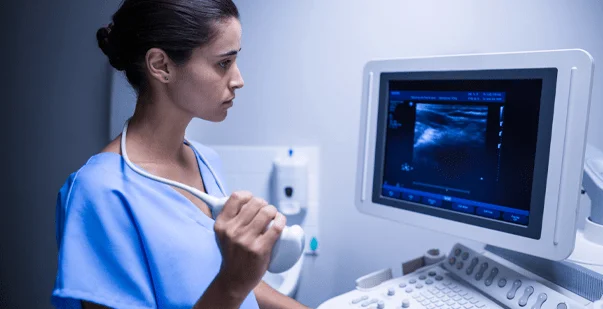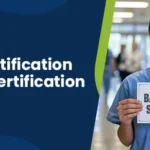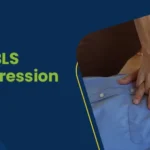If you wish to begin your career as a cardiac sonographer, you have chosen a career filled with passion for precision imaging. With the rising demand of skilled professionals in cardiovascular health, it is important to have an equal number of cardiac sonographers on board. According to the US bureau of labor statistics there has been a 12% growth in the employment of cardiac sonographers. The surge in demand is owed to the increase in the number of diagnostic services, which in turn is the result of increasing cardiovascular diseases in the population. As heart diseases remain to be the leading cause of mortality in the world, the need for skilled professionals becomes critical.
So if you want the answer to “How do you become a cardiac sonographer”, you have come to the right place. To carve out a fulfilling career as a cardiac sonographer, read along and be prepared to take the first step towards becoming a professional echocardiography sonographer.
Master ACLS Now
Get ACLS certified with confidence
What are the steps to become a cardiac sonographer?
Becoming a cardiac sonographer is the perfect career option for those passionate about healthcare and precision imaging. This field gives the opportunity to directly impact a patient’s life by making a proper diagnosis via images and other reports. This career choice demands a structured set of steps including education, training and certification.
Let’s go through the steps in detail-
- Earn a High School Diploma or Equivalent:
- Obtain a high school diploma or GED equivalent, focusing on courses in mathematics, biology, physics, and anatomy to lay a strong foundation for future studies.
- Pursue a Formal Education:
- Enroll in an accredited diagnostic medical sonography program with a concentration in cardiac sonography.
- Complete coursework covering anatomy, physiology, medical terminology, ultrasound physics, and cardiovascular sonography techniques.
- Gain Clinical Experience:
- Participate in clinical internships or externships arranged through the educational program, providing hands-on experience in cardiac imaging under the supervision of experienced sonographers and physicians.
- Obtain Specialized Training:
- Pursue additional training specifically focused on cardiac sonography, either through advanced coursework or specialized workshops and seminars.
- Obtain Professional Certification:
- Consider obtaining certification through organizations that provide flexible yet comprehensive courses.
- Certification typically requires passing an exam demonstrating proficiency in cardiac sonography principles and techniques.
- Continue Education and Professional Development:
- Stay updated on advancements in cardiac imaging technology, procedures, and guidelines through continuing education courses, conferences, and professional networking.
Read More: Acls promo code
What are the few challenges that cardiac sonographers face?
To give you a complete overview of cardiac sonography as a chosen career path, we have pointed out the challenges that are often faced by technicians. Let’s explore the key challenges that will help you stay prepared beforehand.
- Technical Complexity:
- Performing cardiac ultrasound imaging requires mastery of complex equipment and specialized techniques, including understanding anatomy variations and adapting to patient conditions.
- Time Pressure:
- Cardiac sonographers often work under tight schedules, with limited time for each imaging session. This can lead to pressure to efficiently acquire high-quality images while ensuring patient comfort.
- Patient Cooperation:
- Some patients may experience anxiety or discomfort during cardiac ultrasound procedures, making it challenging for sonographers to obtain optimal imaging while ensuring patient cooperation and comfort.
- Physical Demands:
- The nature of the job involves prolonged periods of standing and maneuvering heavy equipment, which can lead to physical strain and fatigue over time.
- Emotional Stress:
- Dealing with patients who may be experiencing serious cardiac conditions can be emotionally taxing for cardiac sonographers, requiring empathy and compassion alongside technical expertise.
- Continuing Education:
- Staying abreast of advancements in cardiac imaging technology and techniques requires ongoing education and professional development, which can be demanding alongside a busy work schedule.
Read More: Who can benefit from an ACLS certification?
Conclusion
Becoming a cardiac sonographer is a journey filled with dedication, education, and commitment. By following the structured steps outlined, aspiring cardiac sonographers can begin their journey dedicated to the crucial task of assessing cardiovascular conditions.
Despite the challenges they may face, cardiac sonographers play an indispensable role in the healthcare system. As the demand for skilled professionals in cardiovascular imaging continues to grow, the role of cardiac sonographers remains vital. Now that we have answered your question “How do you become a cardiac sonographer,” you can now chase your dream with rigorous training, ongoing education, and a passion for patient care.
Resources:
https://college.mayo.edu/academics/explore-health-care-careers/careers-a-z/cardiac-sonographer/
https://www.indeed.com/career-advice/career-development/how-to-become-a-cardiac-sonographer
https://www.allalliedhealthschools.com/specialties/cardiovascular-technologist/
https://www.concorde.edu/blog/how-become-cardiac-sonographer
https://wcui.edu/blog-post/11-things-to-know-before-becoming-a-cardiac-sonographer/
https://www.indeed.com/career-advice/careers/what-does-a-cardiac-sonographer-do







